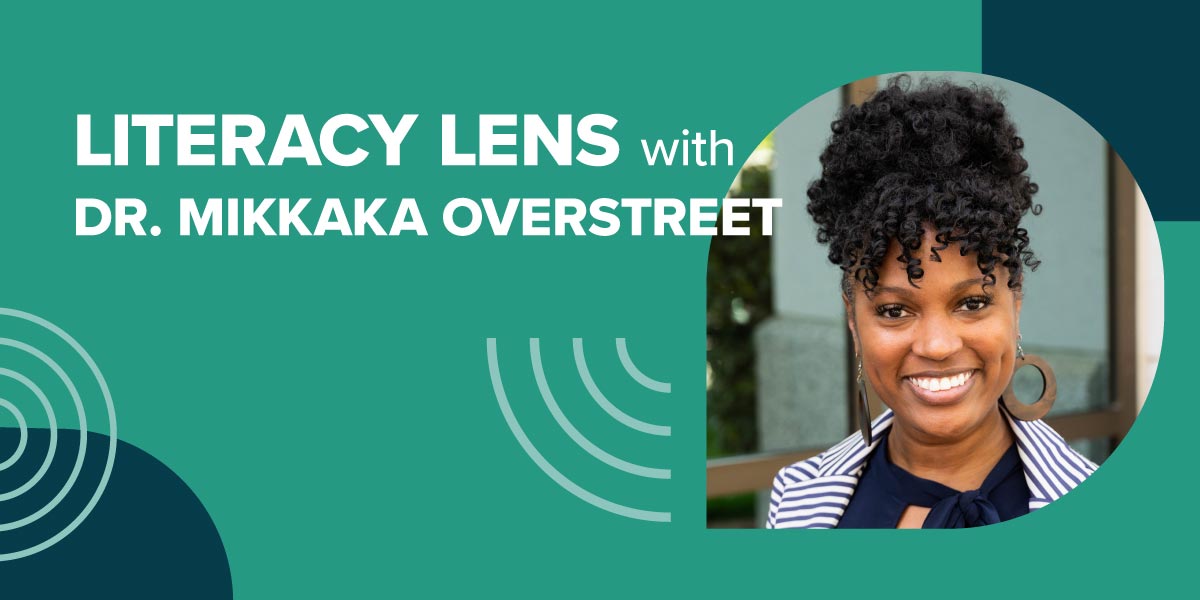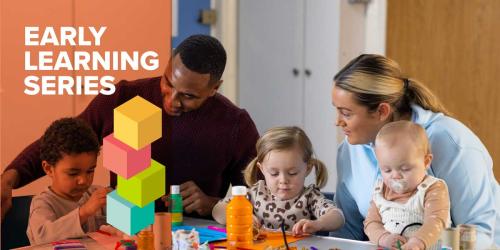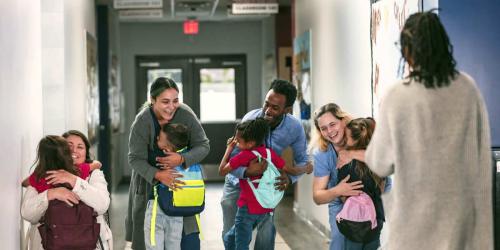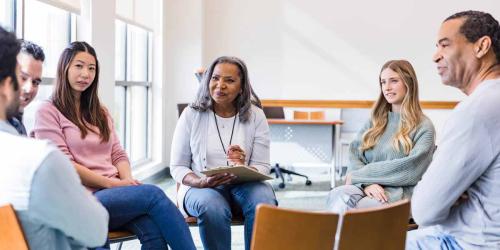Literacy Lens: A Love Letter to Libraries

Is there any place as perfect as a library? As a child, my grandmother fed my voracious reading habits with regular trips to the public library during my summer visits to her house. When I was with my mother, we would go to the library so that she could access the internet, use the copier or fax machine, and take advantage of other resources. Meanwhile, I’d peruse the stacks, carefully selecting my 10 books (the checkout limit for kids). Poor as we were, I always walked out with my book haul feeling like a Rockefeller.
The public library remains one of the few spaces in our society that offers access to vital resources, without the requirement of spending money. Books, audiovisual materials, workshops, public meeting spaces—libraries provide all these things and more to their communities. They are a beacon of equity and access in our systemically unequal society.
In honor of National Library Week, I want to talk about the importance and impact of libraries on literacy and life. According to the American Library Association (ALA), National Library Week is a time to remember “there’s more to the story”:
[I]n addition to the books in library collections, available in a variety of formats, libraries offer so much more. Many libraries now lend items like museum passes, games, musical instruments, and tools. Library programming brings communities together for entertainment, education, and connection through book clubs, storytimes, movie nights, crafting classes, and lectures. And library infrastructure advances communities, providing internet and technology access, literacy skills, and support for businesses, job seekers, and entrepreneurs.
–ALA National Library Week Press Kit
Since 1958, National Library Week has celebrated school, public, academic, and special libraries. These libraries are essential “third spaces/places” between the home and workplace, where people build community. A 2015 Pew survey found that 90 percent of American adults believe the library to be a welcoming and friendly place, and 50 percent have used a public library in the past 12 months. Similarly, two-thirds of the adults surveyed said that closing the library would have a major impact on their community. As impressive as these statistics are, they only hint at the larger role public libraries play in communities all across the country.
Libraries Support School Readiness and Lifelong Literacy
The library is so much more than a place to borrow books. Many public libraries provide wraparound services, including programs that support children and families in preparing for formal schooling. As children grow older, libraries offer access to technology and training and resources to improve study and research skills. Most libraries offer programs for adults with low literacy, offer support in finding and applying for jobs, and provide training in other life skills. Ultimately, libraries serve people across the lifespan.
For example, in the primarily Hispanic and Latinx community served by the Oceano branch of San Luis Obispo Public Libraries, in California, many families participate in the Raising a Reader program offered through the library. After just three months, participating parents reported an increase in time spent reading to their children from 59 percent to 85 percent, as well as an increase in library usage from 38 percent to 69 percent.
Similarly, Listos para el kinder, a culturally responsive 12-week kindergarten readiness program offered by the Multnomah County Library system, in Oregon, achieved remarkable results. An external evaluation conducted by Education Northwest found that children who participated in the program made significant improvement in three critical areas: approaches to learning, social and emotional development, and language and literacy skills. The largest gains were made by children who had not previously participated in an early childhood program and whose parents did not have a high school diploma. These children went from an average baseline score of 10.6 to a follow up score of 33.
Meanwhile, reading aloud to children has been linked to multiple academic benefits, including stronger phonemic awareness, improved comprehension and vocabulary knowledge, and increased likelihood of later reading success. Furthermore, social-emotional benefits include character development and greater emotional intelligence, as well as decreased levels of aggression, hyperactivity, and attention difficulties.
It’s not just public libraries that impact student achievement; research suggests that students in schools with high-quality school library programs earn higher standardized test scores, even when controlling for socioeconomic and other factors. These impacts are greater for students from marginalized populations. Grade 4 National Assessment of Educational Progress reading data showed that in states that gained school librarians between testing cycles, average scores improved for Black and Latinx students and students with disabilities, while in states that lost school librarians, the scores of multilingual learner students decreased by 3 percent. Additionally, graduation rates and test scores in reading and math were significantly higher in schools with high-quality libraries and certified librarians, even after controlling for school size and poverty.
Libraries Fill Needs Unmet by Other Public Institutions
ALA statistics show that 94 percent of libraries offer study space for children, 95 percent offer summer reading programs, 89 percent provide story hours, and 83 percent work cooperatively with schools. Since research shows that children who have access to more books read more and thus attain better reading outcomes, the free access to literature that libraries provide is invaluable. Illustrating this point, a 2007 study by the National Center for Education Statistics showed a significant correlation between reading scores and libraries’ circulation of children’s materials:
Colorado, Minnesota, and Ohio ... ranked in the top quartiles (the top 25 percent) in both reading scores and children’s circulation per capita. Of states ranking in the top half of all states on reading scores, more than four-fifths (82 percent) ranked in the top half on circulation of children’s materials per capita. Conversely, four out of five states (83 percent) in the bottom half on reading scores also rank in the bottom half on children’s circulation.
–The Link Between Public Libraries and Early Reading Success
Additionally, libraries provide summer programming to combat what is known as the “summer slide.” This is the phenomenon in which children regress during the summer months, losing as much as 20 percent of their school-year gains in reading. Consequently, library summer reading programs are especially popular around the United States. For example, 45 percent of elementary school children in Denver, Colorado, and 30,000 children in Louisville, Kentucky, take part in such programs. In an experimental study of summer reading program effectiveness, researchers found that students who attended such programs read closer to grade level than their peers who did not attend.
Libraries not only bridge gaps in formal education, they also provide vital resources for health, personal advancement, and safety. For example, in 2015, 10 percent of Philadelphia’s 5.8 million in-person library users accessed programs for nutrition, trauma, mental health, and other wellness-related resources. In Hartford, Connecticut, the library supports new immigrants with employment services, legal orientation, language classes, and other programs to help them acclimate to their new home. The Dallas Public Library and other library systems around the country offer special programming to support unhoused persons. Unquestionably, libraries provide vital services to our most vulnerable populations.
Call to Action: Support Your Local Libraries
Like many people, my life would be drastically different if I had not had access to school, academic, and public libraries. They were the places where I did research and got help with tough assignments during my K–12 schooling. I spent hundreds of hours in the beautiful southwest branch of the Louisville Free Public Library writing my dissertation. Even now, I regularly check out audiobooks through the very convenient Libby app, and I even pay for membership to the nearest big city library so that I can access a wider selection. Some of my favorite people are librarians, and they need you.
Regardless of your usage of public libraries, they are vital to every community, and they need your support. Here are a few easy ways you can help:
- Check out books! Library usage data is a crucial factor in funding. When you utilize the library’s resources, you show the government that libraries are needed.
- Become a Friend of the Library. This program enables you to be an advocate for the library in your community, to support and organize fundraising efforts, and to connect with the community.
- Contact your government representatives and tell them to support library funding.
- Volunteer your time. Local libraries are often understaffed, and your help can make a huge difference.
- Donate money. If you can afford to contribute, this is the easiest way to provide support. Check to see if your employer matches nonprofit donations and double your impact.
- Participate in virtual events. Even if you can’t physically visit the library, you can take advantage of their online offerings. It still counts as usage and demonstrates the need for the library.
- Support libraries on social media. It’s a great way to utilize your sphere of influence.
For more information on supporting libraries, visit the American Library Association.



